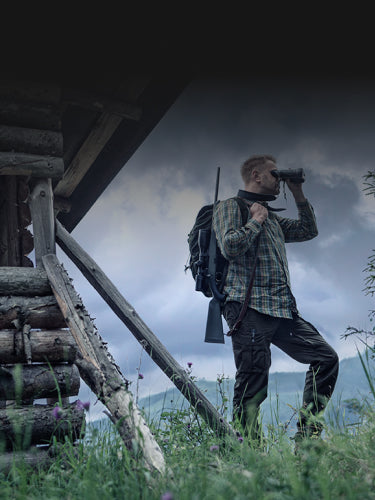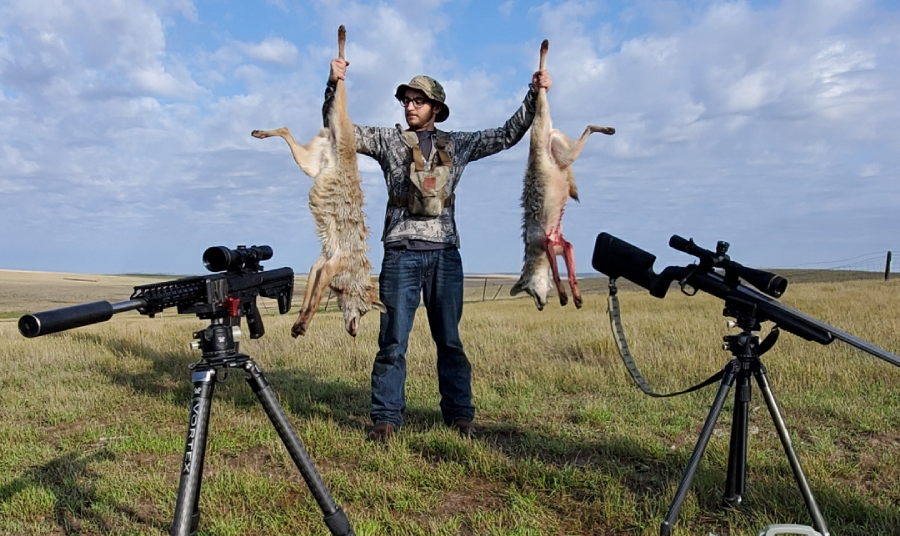South Dakota is home to some of the best coyote hunting country in the United States. There are many different ways to hunt coyotes, but I want to talk about the vast array of terrain that South Dakota provides for coyote hunting. From flat crop fields to rolling hills, open prairies, river bluffs, and the rocky Black Hills, South Dakota offers opportunities for every style of coyote hunter.

The first kind of terrain that South Dakota offers is flat cropland, which makes up much of South Dakota’s landscape. The most common crops that farmers plant are corn, soybeans, sunflowers, winter radishes, and winter wheat. This type of terrain is best utilized for coyote hunting after the crops have been harvested, as coyotes will seek out freshly picked fields to hunt for mice and rabbits. Hunting during the summer months when crops are fully grown presents many challenges due to limited visibility. After harvest, this terrain is best suited for night hunts using thermal imaging scopes, such as the Pulsar Thermion 2 LRF XP50 Pro, which, in my personal experience, has given the best clarity for precision shooting, target identification, and distance calculation with its integrated laser rangefinder. Coyotes generally believe they are well camouflaged in the darkness, but a high quality thermal riflescope can generate sharp, finely detailed pictures even during a pitch black night.

The next type of terrain is rolling hills. This land is best suited for day hunting because it is often desolate and very much unpopulated. The rolling hills are home to grazing land for cattle, big game animals such as deer and antelope, and scattered prairie dog towns. South Dakota offers a large section of the state with this terrain, particularly in the public grasslands. Daytime coyote hunters will have the most success on this ground because many of the coyotes have never been called before, meaning they are uneducated and will likely respond to a call without feeling threatened. Another reason daytime hunters will find success in the rolling hills is because they can easily camouflage themselves in the grass or against rocks, making it harder for coyotes to pinpoint them as they would in a flat field. The rolling hills have the highest coyote population in the state and are an excellent option for quick success.

The open prairie is similar to the rolling hills in that it also features rolling terrain and stretches for miles at a time without any signs of habitation. The open prairie is often barren and dry, yet it still offers many opportunities for both day and night hunters. Prairie dogs, jackrabbits, rattlesnakes, and other small rodents call the prairie home, providing a great food source for coyotes.

The river bluffs probably offer the most diverse options for hunting coyotes. The bluffs hold many coyotes, making them an excellent starting point for hunters. Much of the river bluff terrain consists of large, often steep hills with expansive open fields or pastures. There are several ways to approach hunting here. One option, which I particularly enjoy, is setting up in the open field or pasture and calling coyotes out of the bluffs. Another option is the opposite: setting up in the bluffs and calling coyotes from the open field. Both approaches, if done correctly, will result in successful coyote hunting, whether it involves close-quarter shooting in the bluffs or taking long shots in the open pasture.
The final type of terrain that South Dakota offers is the Black Hills. The Black Hills are found in the western part of the state and feature thick cover of bushes and pine trees, often leading coyote hunters to use shotguns for close-quarters shooting. The Black Hills don’t offer as large an area of huntable land compared to the rest of the state, but they do have plenty of coyotes, which means hunters have ample opportunities to shoot. The steep and thick terrain of the Black Hills makes it a great challenge for both the hunter and the hunted.
Whether you’re hunting in the open croplands or the thick brush of the Black Hills, South Dakota offers the most diverse, intense, and best coyote hunting grounds in the nation. Whether you’re an amateur coyote hunter or a professional, South Dakota provides the best opportunities for hunters of all experience levels. Coyote hunting is one of the most fun, challenging, and exhilarating experiences that any hunter can have.
If our products have helped you in any way, share your story with us! Accepted stories will receive a 20% discount code.
FAQs
1. What type of terrain is best for coyote hunting in South Dakota?
South Dakota offers a variety of terrains for coyote hunting, including flat cropland, rolling hills, open prairie, and river bluffs.
2. When is the best time to hunt coyotes in flat cropland?
The best time to hunt coyotes in flat cropland is after the crops have been harvested when coyotes seek out freshly picked fields to hunt for mice and rabbits.
3. Why is daytime hunting recommended in rolling hills?
Daytime hunting is recommended in rolling hills because many coyotes have never been called before, making them more likely to respond to a call without feeling threatened.
4. What kind of wildlife can be found in the open prairie?
The open prairie is home to prairie dogs, jackrabbits, rattlesnakes, and other small rodents, providing a great food source for coyotes.
5. What makes river bluffs an excellent starting point for hunting coyotes?
River bluffs hold many coyotes and consist of large, often steep hills with expansive open fields or pastures, offering diverse hunting options.





